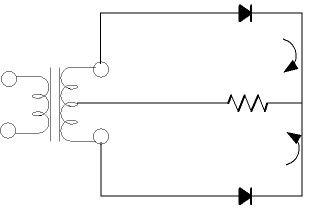170625-1617 EDT
Some scope plots.
The circuit consists of a single transformer secondary winding with one common terminal, call it ground, the other terminal is a 60 Hz sine wave of some value Vpeak relative to ground. The instantaneous value swings from a maximum positive peak value of +Vpeak to a maximum (possibly you may want to call it a minimum) value of -Vpeak relative to the common measuring point, ground.
The load applied is a resistor with a series diode, and the two orientations of the diode.
The plots are from a scope with a suitable time base selected, and synchronized always from the AC line in exactly the same way.
Red plot is source voltage, blue is load resistor voltage, or current.
Plot 1 --- Voltage only, no load. Note the positive-negative symmetry of the wave form. Time synchronization is at the middle of the plot.
View attachment 17857
.
Plot 2 --- Voltage and associated loading on only the positive half of the cycle.
The diode only conducts when its anode is more positive than its cathode. In this case the cathode is connected to the load resistor. The resistor only has a voltage drop across it when current flows. Current only flows thru the diode when the source voltage is positive because of the selected diode orientation.
No current and the resistor drop is zero.
Note: the positive voltage is slightly depressed compared to no load, and the negative peak is unaffected. This is because of the transformer internal impedance.
The waveforms are measurements relative to common (ground). The load waveform is always above ground and thus its average DC value is positive.
View attachment 17858
.
Plot 3 --- Voltage and associated loading on only the negative half of the cycle.
Relative to Plot 2 this plot has the diode orientation reversed.
The diode only conducts when its anode is more positive than its cathode. In this case the anode is connected to the load resistor. The resistor only has a voltage drop across it when current flows. Current only flows thru the diode when the source voltage is negative because of the diode orientation.
No current and the resistor drop is zero.
Note: the negative source voltage is slightly depressed compared to no load, and the negative peak is unaffected. This is because of the transformer internal impedance.
The waveforms are measurements relative to common (ground). The load waveform is always below ground and thus its average DC value is negative. The average value is about 0.318 times Vpeak.
View attachment 17859
.
.
.





